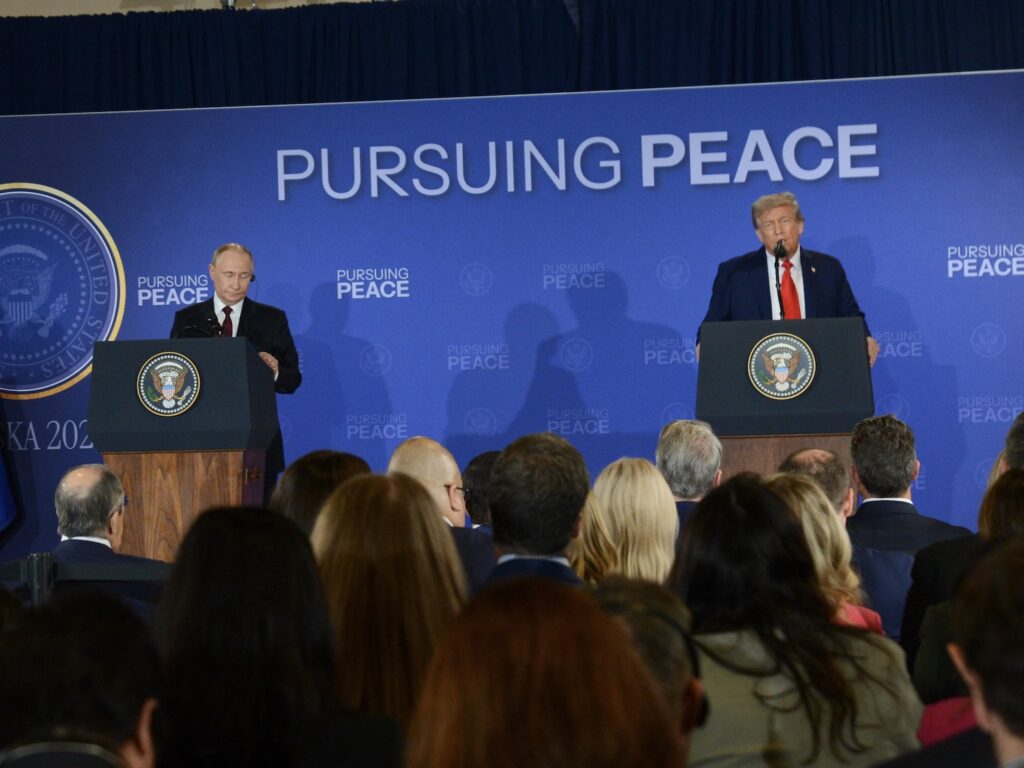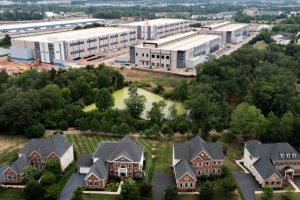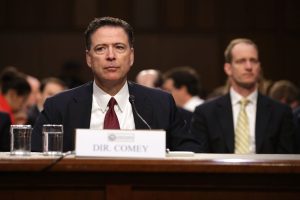
President Donald Trump and Russian President Vladimir Putin speak Friday, Aug. 15, 2025, at Joint Base Elmendorf-Richardson in Anchorage, Alaska. (Photo by James Brooks/Alaska Beacon)
President Donald Trump’s high-profile meeting with Russian President Vladimir Putin adjourned Friday without announcing a breakthrough in negotiations to end Russia’s three-year-old invasion of Ukraine.
“We didn’t get there, but we have a very good chance of getting there,” Trump said after several hours of closed-door negotiations with Putin in Anchorage.
The talks ended sooner than previously expected, indicating that the two leaders may be far apart.
In a pair of brief speeches, the leaders said they were optimistic about improvements in relations between the United States and Russia. Putin said they had reached “an agreement,” according to a provided translation, but neither Putin nor Trump provided any details about what that agreement entails.
Before the meeting, Trump had indicated that he might favor a land exchange between Russia and Ukraine as part of a peace deal. European leaders, including Ukraine President Volodymyr Zelenskyy, said they did not support any deal that would require Ukraine to surrender territory.
“We had an extremely productive meeting, and many points were agreed to,” Trump said Friday without explaining what those points were. “There are just a very few that are left. Some are not that significant. One is probably the most significant, but we have a very good chance of getting there. We didn’t get there, but we have a very good chance of getting there.”
Curated news from our national network: Sign up for our free newsletter.
During a planned news conference, Putin spoke for only eight minutes, and Trump, who normally delivers lengthy and meandering remarks, spoke for only four and appeared tired.
Both men then left without taking any questions from a room full of international journalists, an action that stunned and confused attendees.
Many of those journalists, as well as Putin, Trump and officials from both Russia and the United States, traveled thousands of miles to meet at Joint Base Elmendorf-Richardson, a base operated by the U.S. Air Force and U.S. Army in Anchorage, Alaska’s largest city.
Because of the summit’s short notice — Trump announced it on social media just one week ago — the city’s hotel rooms were all but sold out, and rental cars were almost impossible to find.
At the University of Alaska Anchorage, members of the Russian delegation, including journalists, were given cots in curtained-off spaces within Alaska Airlines Arena.
En route to Alaska, Trump told reporters traveling aboard Air Force One that he was “not going to be happy” if there was no ceasefire between Russia and Ukraine by the end of the day, according to news reports.
He said he didn’t know what would make the summit a success and said there was “nothing set in stone.”
As originally announced, Trump and Putin were supposed to meet in a one-on-one meeting Friday morning. That changed to a three-on-three, with Secretary of State Marco Rubio and Trump’s Russia envoy, Steve Witkoff, joining Trump.
The change didn’t appear to result in even a temporary ceasefire in Ukraine, whose leaders were not invited to Alaska.
Ahead of the Trump-Putin meeting, disgruntled Alaskans held protests across the state, waving Ukrainian flags and urging the United States to support Ukraine’s fight against Russia.
A smaller counterprotest in support of the president, hosted by Alaska Republicans, took place just as Air Force One landed in Alaska about 11 a.m. Friday morning.
A poll conducted by Alaska Survey Research in advance of the meeting indicated that 86% of Alaskans hold negative views of Vladimir Putin and that Trump’s approval rating has dipped below 50% in Alaska, where voters have chosen Trump in the past three presidential elections.
About 30 minutes after Trump’s arrival, Putin’s plane landed at the Anchorage military base after a stop in Magadan, in the Russian Far East.
Trump disembarked first and greeted Putin with applause and a firm handshake before inviting the Russian leader into the presidential limousine.
Putin’s arrival in the United States represented a kind of diplomatic victory for the Russian leader, who has been indicted by the International Criminal Court and faces arrest if he visits many countries, including most in Europe. The Trump administration opposes the ICC and does not typically enforce its arrest warrants.
Additionally, Trump has declined to impose additional financial and economic sanctions on Russia and Russian officials, something he had pledged to do if Russia did not agree to a ceasefire in Ukraine.
Eric Croft, chair of the Alaska Democratic Party, said in a written statement, “Just as we expected, Trump failed to accomplish anything meaningful by inviting a war criminal to a meeting on American soil without Ukrainian representation at the table. … To be frank, we are disappointed, but not surprised, and we will not back down from applying pressure to Trump to achieve lasting peace in Ukraine.”
On Friday, Putin and Trump, accompanied by aides, talked for at least 2 ½ hours. The content of those discussions was not revealed.
Putin boarded his plane for a return flight about 4 p.m. Trump was scheduled to depart before 6 p.m.
Their original schedule had called for more lengthy discussions, but reporters were called to a news conference sooner than expected.
That appeared to be in line with remarks Trump gave the day before, in the Oval Office.
“I would say that (on Friday), all I want to do is set the table for the next meeting, which should happen shortly,” Trump said on Thursday. “I’d like to see it happen very quickly, very shortly after this meeting. I’d like to see it actually happen in Alaska … because it’s so much easier.”
On Friday, Putin delivered his remarks mostly in Russian but joked in English that maybe next time, they could meet in Moscow.
Trump said he would “get a little heat” if he agreed to that, “but I could see it possibly happening.”
Even without a breakthrough peace deal, Friday’s meeting between the two presidents was a historic one. It was the first time since Ronald Reagan met Pope John Paul II in Fairbanks that an American president had hosted a foreign leader in Alaska.
Before Friday, no Russian leader had ever visited Alaska — a place whose territory nominally belonged to Russia from the 1700s until 1867.





